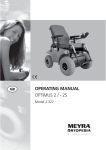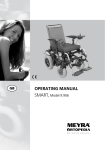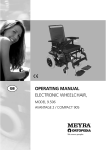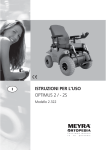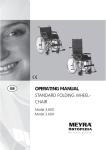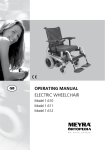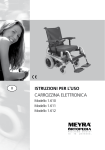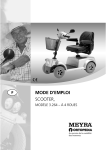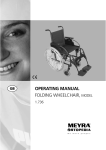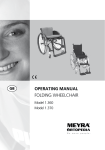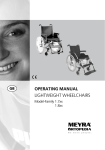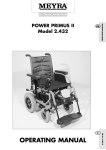Download Meyra 1.595-603 Specifications
Transcript
GB OPERATING MANUAL ELECTRIC WHEELCHAIR Model 1.595 – 603 vertical junior Model 1.595 – 604 vertical senior We move people. Contents Introduction .................................................................................................. 6 Indications..................................................................................................... 7 Acceptance .................................................................................................... 7 Adjustment ................................................................................................... 7 Specifications................................................................................................ 8 Use ................................................................................................................. 8 Overview ....................................................................................................... 9 Model: 1.595 – 603 / 1.595 – 604 .........................................................................9 Quick guide ................................................................................................. 10 Driving behavior ........................................................................................ 12 Speed limitation .................................................................................................12 Functional checks ...............................................................................................12 Brakes .......................................................................................................... 13 Operating brakes................................................................................................13 Parking brake .....................................................................................................13 Selection lever.....................................................................................................13 Locking the brake .........................................................................................13 Releasing the brake ......................................................................................13 Drive-/push mode ...............................................................................................14 Selecting the push mode ..............................................................................14 Selecting the motor mode ...........................................................................14 Selecting the operation ............................................................................. 15 Pre-operation checks ..........................................................................................16 Charging procedure ......................................................................................17 Operating module ...................................................................................... 18 Positioning the operating module....................................................................18 Function description .....................................................................................18 Horizontal adjustment..................................................................................18 Turning the operating module to the side .................................................19 Remove the operating module....................................................................20 Fitting of the operating module..................................................................20 2 Arm supports .............................................................................................. 21 Angle of the arm supports ...........................................................................21 Swivelling up the arm supports ...................................................................22 Swivelling down the arm supports ..............................................................22 Back support ............................................................................................... 23 Head support .............................................................................................. 23 Adjustment of the head support .................................................................23 Removing and height adjusting the head support ....................................23 Holder for chin operation ............................................................................23 Leg support ................................................................................................. 24 Folding up the leg support ..........................................................................24 Knee cushions .....................................................................................................25 Removing/attaching the knee cushions ......................................................25 Side cushions .............................................................................................. 26 Adjusting the side cushions ..........................................................................26 Removing the side cushions .........................................................................26 Removing / attaching the side cushion pad................................................26 Back support cushions ............................................................................... 26 Torso supports ............................................................................................ 27 Splay wedge ............................................................................................... 27 Removing/attaching the splay wedge .........................................................27 Chest support ............................................................................................. 28 Removing/attaching the chest support .......................................................28 Depth adjustment of the chest support ......................................................28 Lifting/lowering the chest support ..............................................................29 Seat .............................................................................................................. 30 Seat inclination (camber) ...................................................................................30 Special safety information for raising the seat, seat height adjustment, standing and lying functions .............................................................................31 Raising the seat ..................................................................................................31 Seat height adjustment .....................................................................................32 Getting up from the sitting position ................................................................33 Lying position .....................................................................................................34 Getting up from the lying position...................................................................35 Adjusting the seat depth ...................................................................................36 3 Chest strap .................................................................................................. 36 Fastening the breast strap ............................................................................36 Opening the breast strap .............................................................................36 Retaining strap ...................................................................................................37 Fastening the retaining strap.......................................................................37 Adjustment of belt length ...........................................................................37 Shoulder strap ....................................................................................................38 Fastening the shoulder strap .......................................................................38 Adjustment of belt length ...........................................................................38 Emergency switch ...................................................................................... 39 Raising the seat .............................................................................................39 Lowering the seat .........................................................................................39 Loading and transportation ...................................................................... 40 Loading ...............................................................................................................40 Transport security ...............................................................................................40 Passenger transport in handicapped transport vehicles (HTV).......................41 Maintenance ............................................................................................... 41 Maintenance .......................................................................................................41 Maintenance schedule ..................................................................................42 Fuses ....................................................................................................................44 Replacing the fuses .......................................................................................44 Tyre damage on pneumatic tyres......................................................................44 Lighting ...............................................................................................................45 Adjusting the headlights ..............................................................................45 Back light .......................................................................................................45 Headlights......................................................................................................46 Indicator .........................................................................................................47 Information for the specialist dealer ................................................................48 Programming the driving behaviour...........................................................48 4 Technical data ............................................................................................. 49 Kilometric performance .....................................................................................49 Fuses ....................................................................................................................50 Lighting ...............................................................................................................50 Vehicle independent data .................................................................................51 Vehicle specific data ...........................................................................................53 Meaning of the labels on the electric wheelchair ...........................................54 Meaning of the symbols on the type plate ......................................................55 Fault correction .......................................................................................... 56 Inspection certificate ................................................................................. 57 Warranty / Guarantee................................................................................. 58 Inspection certificate for transfer .....................................................................59 5 INTRODUCTION We thank you for the confidence you have placed in our company by choosing an electric wheelchair from this series. The model of your selection, fulfils the wish for mobility and more independence by way of a new styling of the proven MEYRA-Ortopedia technology. With all equipment and their accessories the electric wheelchair offers the respective adaptation to your disability. Like any other vehicle, an electric wheelchair is a technical aid. It is subject to explanations, requires regular care and can cause danger when used improperly. The correct handling must therefore be learned. This operating manual is to help you get accustomed to the handling of the electric wheelchair as well as to prevent accidents. ☞ Note: Please note that the illustrated equipment variants can deviate from your model. – We have therefore also listed chapters with options that might not be applicable for your vehicle. ! Attention: Read and observe the following documentation belonging to the electric wheelchair before first use: – this operating manual, – the operating manual < Operating module NEMO >, – the safety and general handling instructions < Electronic vehicles >. 6 ☞ Note: Children and juveniles should read the documentation belonging to the electric wheelchair together with their parents respectively a supervisor or accompanying person before first use. For users with visual impairments the PDF-files of the above mentioned documents can be accessed on our website < www.meyra-ortopedia.com >. ☞ Contact your specialist dealer when required. Alternatively users with visual impairments can have the documentation read out by a helper. INDICATIONS ADJUSTMENT If the following indications occur we recommend the application of this mobility product: ☞ Note: The first adjustment of the electric wheelchair to the user as well as the required handling introduction is carried out by educated personnel. ☞ Walking disability resp. extremely limited walking ability as part of the basic need to move around in your own home. ☞ The need to be able to leave home for a short walk in fresh air or in order to reach the places, commonly in the perimeter of the home, required to fulfil basic needs. The electric wheelchair is handed over to the user in an operationally ready state under observance of all relevant safety regulations and adjusted to the individual requirements. ☞ Note: Existing manual adjustments are to be adjusted for the drive mode in such a fashion that a secure handling of the electric wheelchair is warranted. ACCEPTANCE All products are checked for faults in the factory and packed in special boxes. ☞ Note: However, we request that you check the vehicle for possible transport damage immediately on receipt – preferably in the presence of the carrier. ☞ Note: The packaging of the electric wheelchair should be stored for a further transport that might become necessary. ! Attention: Always have retrospective adaptation and adjustment work carried out by a specialist dealer. ☞ Note: ☞ We recommend a regular control if the wheelchair adjustment in order to ensure a long-term optimal provision even with changing illness/handicap patterns of the user. ☞ Especially for children and juveniles an adjustment every 6 months is recommendable. 7 SPECIFICATIONS The electric wheelchair is an environment-friendly electronic vehicle. It is a multifunction wheelchair, compact and agile with reclining and rising functions, especially designed for the extreme provision of adolescents and adults, for indoor and outdoor use on level, firm surfaces. With all equipment and their accessories the electric wheelchair offers die respective adaptation to your respective disability. ☞ The model has been assigned the 'Use Class B' as per the EN12184 standard. USE The electric wheelchair is solely designated to transport one person instructed in its use. Other pulling or transporting uses do not comply with its intended purpose. Before use on outdoor public routes the electric wheelchair is to be fit with an optionally available lighting jig. Depending on the leg support adjustment it can cross obstacles with a max. height of 40 mm resp. 70 mm. ☞ Adjust the seat or leg support for the required ground clearance of the leg support-support castors to overcome obstacles. 8 OVERVIEW Model: 1.595 – 603 / 1.595 – 604 The overview shows the most important components and operating equipment. 1 2 3 10 11 12 4 5 6 14 9 8 7 Pos. Description 1 2 3 4 5 6 7 8 9 13 Breast strap Back support upholstery Arm support Side cushion Knee cushion Calf pad Leg support / Footplate Leg support-support castor Selection lever drive-/push mode Pos. Description 10 11 12 13 14 Seat unit Head support Operating module Drive wheel Steering wheel 9 QUICK GUIDE Locking down the adjustments ☞ Note: 1. The leg support adjustment is locked when the reclining function is activated. ☞ First bring the reclining function into the basic position. The following quick guide does not replace the reading and observing of the documentation belonging to the wheelchair. Operation of the adjustments through the operating module 6 adjustment menus can be selected with the Mode – key: ☞ Back support with arm support adjustment ☞ Camber/ seat inclination ☞ Leg supports with length alignment adjustment ☞ Reclining function ☞ Seat height adjustment ☞ Standing function After selecting the menu the adjustment from the basic position can be activated with the Plus - key, right turn signal - key or by moving the joystick to the right. After selecting the menu the adjustment into the basic position can be activated with the Minus - key, left turn signal - key or by moving the joystick to the left. 10 2. During the adjustment from the lying position into the standing position other adjustment functions, with the exception of the back support adjustment, are locked. 3. All other adjustment functions are locked when the standing function is activated. 4. The speed is limited to 3 km/h when the seat height adjustment is in the base position or less than 10 mm below or more than 100 mm above the base position. External adjustment keyboard The adjustments can be activated directly through the external adjustment keyboard. The two upper keys correspond to the first adjustment menu: 1. ☞ The right keys correspond to the 2. plus-key and the left keys the minus-key of the operating module. 3. 1. Back support with arm support adjustment 4. 2. Camber/ seat inclination 5. 3. Leg supports with length alignment adjustment 6. 4. Reclining function 5. Seat height adjustment 6. Standing function 11 DRIVING BEHAVIOR Optimising the driving behaviour of the electric wheelchair with the personal circumstances is to be co-ordinated by our customer service technician and your specialist dealer or therapist. The adaptability offers sufficient driving comfort as well as a high operating safety. You determine the speed and driving direction yourself when driving through the movement of the joystick and the maximum top speed setting of your electric wheelchair. Speed limitation The speed limitation to 3 km/h serves the safety and is activated in the following settings: ☞ Seat height lower than 10 mm ☞ Seat height higher than 100 mm ☞ Back support in final position ☞ Reclining function in final position ☞ From the start of the rising function 12 Functional checks The functions and safety of the electric wheelchair must be checked before the start of each journey. ☞ For this observe chapter < Inspections before starting to drive > in the Operating manual of the Operating module NEMO. BRAKES Operating brakes 3 The motors work electrically as operating brake and carefully brake the electric wheelchair down without jerks to stillstand. Parking brake 1 The parking brakes only work when the selection lever is in the drive mode position. They disengage automatically when the wheelchair starts off. They are disengaged manually by moving the selection lever to the push mode position. Also view chapter < Drive-/push mode >. Selection lever 2 Locking the brake Swivel the selection lever forward as far as possible [1]. ! Attention: It is impossible to push the electric wheelchair when in drive mode. • Inadvertently knocking the control lever will set the electric wheelchair in motion without control! – Danger of accidents! • The brake performance reduces with the brake pads are worn. Releasing the brake Activate the pull knob (3) on the selection lever and swivel the selection lever back as far as possible [2]. ! Attention: Do not get into/out of the electric wheelchair unless it is switched off and the selection lever has been set to "drive mode"! 13 Drive-/push mode 1 The lever (1) for switching the drive motors between the drive mode and push mode is located on the right side of the electric wheelchair. Attention: Push the electric wheelchair only for manoeuvring or in emergency cases but never on gradients. • The electric magnetic brakes are switched off in the push mode. A braking of the electric wheelchair is then only possible by switching to the drive mode. Therefore do not switch to the push mode on gradients. ! 3 2 Selecting the push mode 1. Switch off the operating module because the pushing will otherwise be made difficult by the electric system. 2. Pull the locking sleeve (3) up and then push the selection lever to the rear [4]. ☞ The electric wheelchair can now be pushed. Selecting the motor mode 1. Push the selection lever to the front (1) until it audibly latches [2]. 2. Switching the operating module on. The vehicle is now ready for use. 14 4 SELECTING THE OPERATION 1 In order to obtain operational readiness of the electric wheelchair the following directions are to be carried out in the indicated order. 1. Shift to drive mode Swivel the selection lever forward as far as possible (1). 2. Check the correct fit of the battery/mains fuse 2 The fuse for the main current has to sit tightly in the fuse holder (2). 3. Checking the position of the operating module The operating module should be positioned in such a way that you can comfortably and safely steer the electric wheelchair. ☞ Therefore observe chapter < Positioning the operating module >. 3 15 4. Switching the operating module on Press the ON/OFF-key on the control panel of the operating module. ☞ Observe the operating manual < Operating module NEMO >. ☞ Note: Only actuate the joystick (1) after the self-test of the electronics has been completed! Pre-operation checks Before starting to drive, the following should be checked: ☞ the battery charge level, ☞ the pre-selected maximum top speed setting. – For this observe the operating manual < Operating module NEMO >. 16 1 Charging procedure 1. Switch the operating module off. The selection lever should be in the drive mode position. 2. Insert the battery charger plug into the operating module (1). ! Attention: Do not insert any objects other than the battery charger plug into the battery charging socket. – Danger of short circuit! 3. Switch on the battery charger, respectively, plug the mains plug of the battery charger into a convenient mains socket. The battery is now charging. ☞ The charging process only runs with an intact battery fuse (2)! 1 2 4. Disconnect the battery charger from the mains socket at the end of the charging process and then pull the charging plug out of the operating module. 17 OPERATING MODULE Positioning the operating module Function description You will find a detailed description of the keys and symbols in the operating manual for < Operating module >. 1 The position of the operating module can be adjusted to suit the individual size of the user. The operating module can also be removed for transportation or storage and can be laid on the seat or stored separately. ! Attention: Switch off the operating module before adjusting/removing it. Horizontal adjustment Slacken the clamping screw (1) for horizontal adjustment. Slide the operating module into the desired position and in doing so carefully guide the cable along. Retighten the clamping screw again securely. 18 2 Turning the operating module to the side With the optional swivel away operating module adapter the operating module can be swivelled back to the side (1) so that it is located parallel to the arm support. This makes it possible, for example: – to drive closer to a table, 1 – remove the operating module more easily. For regular drive mode the operating module can be swivelled back toward the front until it engages back into the locking catch (2). ☞ Note: ☞ Press it toward the swivelling device for easier swivelling. 2 ☞ Should the operating module be positioned too close to the arm support, move it slightly forward before swivelling. ! Attention: Do not grab into the area of the cross brace. – Danger of jamming! 19 Remove the operating module Swivel the operating module to the side first before removing it (1). – Loosen the clamping screw (4) of the clamping guide and pull the operating module out toward the front. ☞ Carefully route the cable when do- 1 ing this. Fitting of the operating module – For drive mode insert the operating module from the front into the bracket. – Swivel the operating module back to the front until it locks into place. – Adjust the operating module to the desired height and retighten the clamping screw (4). ☞ Carefully route the cable when doing this. 20 4 ARM SUPPORTS The arm supports can be adjusted in height by a specialist dealer to suit the needs of the user. ! Attention: Do not use the arm supports to lift or carry the wheelchair. 1 Angle of the arm supports The angle of the arm supports can be adjusted to the desires of the user. ☞ Note: During the electric adjustment of the back support the arm supports are automatically raised/lowered into a comfortable position of the arm support pads (1). 21 Swivelling up the arm supports The arm supports can be swivelled upward when necessary (1). – Pull out the button (2) that locks down the arm support and swivel the arm support up as far as possible. ☞ Note: ☞ Support the arm support slightly 1 with one hand. – This makes it easier to use the locking button of the arm support. ☞ The button (2) that locks the arm support must visibly lock into place again (3). 2 Swivelling down the arm supports – Pull out the button (2) that locks down the arm support and swivel the arm support down as far as possible (4). ☞ Note: The locking button (2) of the arm support must visibly lock into place. 2 3 4 22 BACK SUPPORT 1 The angle of the back support (1) can be adjusted through the operating module. ☞ Note: ☞ Also view chapter < Angle of the arm supports >. HEAD SUPPORT 2 The head support (2) is swivel proof, height and depth adjustable as well as removable. 3 3 ☞ Note: We recommend the fitting of a rear-view mirror for driving with a head support. 5 4 Adjustment of the head support After loosening the clamping levers (3) the head support can be adjusted to the desired position. Afterwards retighten the clamping levers (3). Removing and height adjusting the head support Loosen the clamping screw (4) to remove or adjust the head support. Either remove the head support or slide it to the desired position. Afterwards retighten the clamping screw (4). Holder for chin operation The holder (5) exists for example in combination with the chin operation. 23 LEG SUPPORT The angle of the leg support (1) can be adjusted through the operating module. ☞ Note: ☞ The positive and negative final position of the leg support can be set by a customer service technician. 1 ☞ For driving outdoors and in order to be able to overcome obstacles, watch for sufficient ground clearance of the front leg support-support castors (2). Folding up the leg support To reduce the overall length, e.g. for transport, the footplate (3) can be folded upward. 24 2 2 3 Knee cushions The knee cushions (1) are height and depth adjustable as well as removable. Removing/attaching cushions the knee 1 In order to remove/attach the knee cushions, pull up the locking lever (2) first. Afterwards remove (3) or attach (4) the knee cushions. ☞ Check the locking function after placing them and letting go of locking lever. 2 4 3 25 SIDE CUSHIONS 1 The side cushions (1) are height, seat width and depth adjustable as well as removable. Adjusting the side cushions 2 After loosening the clamping lever (2) the respective side cushion can be adjusted to the desired height and position. Afterwards retighten the clamping lever (2). Removing the side cushions After loosening the clamping lever (2) the respective side cushion can be removed or inserted. Afterwards retighten the clamping lever (2). 3 Removing / attaching the side cushion pad Loosen the respective velcro strap (3) in order to remove the side cushion pads. Press the side cushion pad onto the respective carrier plate to reattach them (closing the velcro strap). BACK SUPPORT CUSHIONS The back support cushions (4) are slid between the back shell and back support upholstery. For this pull the back support upholstery forward and position the respective back support cushion (4). 26 4 TORSO SUPPORTS The torso supports (1) are continuously height, width and depth adjustable as well as removable. SPLAY WEDGE The splay wedge (2) can also be mounted retrospectively in a specialist workshop. Removing/attaching wedge the 1 splay Loosen the clamping screw (4) for removal (3) and attachment (5). ☞ Retighten the clamping screw (4) after attaching as well as removing the splay wedge. ☞ The splay wedge is to be removed before activating the electrically lowering footboard. 4 2 3 27 CHEST SUPPORT The chest support (1) stabilises the upper body especially in the upright position. Removing/attaching support the chest Loosen the clamping screw (3) on both sides in order to remove/insert the chest support. 1 ☞ Note: Secure the chest support with one hand against unintentionally falling down. Afterward remove the chest support (2) or insert it at level height (1). ☞ In order to clamp the chest support, the tip of the clamping screw (3) must be screwed into the desired dent of the telescopic tube. 2 Depth adjustment of the chest support Contact your specialist workshop for depth adjustment of the chest support. 3 28 Lifting/lowering the chest support After loosening the clamping screw (5) on both sides, disconnect the toothing and turn the chest support to the desired position (6). ! • 5 Attention: In doing so watch for a stable support function in the upright position. Observe that no objects, such as pens, snaps, buttons or similar are located between the chest cushion and body. – Danger of pressure sores. Afterwards retighten the clamping screw (5) on both sides. ☞ Note: In doing so the teeth of the angle adjustment must join again ! 6 Attention: Ensure the secure fit of the chest support. 29 SEAT ☞ Note: ☞ Observe the operating manual < Operating module NEMO >. ☞ Observe chapter < Technical data >. Seat inclination (camber) The seat inclination (1) can be adjusted through the operating module. 1 30 Special safety information for raising the seat, seat height adjustment, standing and lying functions ! Attention: Only drive on slopes, inclines and obstacles in the basic position of the seat rising function, seat height adjustment and the standing resp. lying function. – Danger of overturning! 1 ☞ Note: ☞ All following adjustment functions should be practised with an attendant or helper. Raising the seat After reaching the maximum seat inclination, after 3 seconds further activation through the operating module, the seat is raised in the back. – This enables you to obtain a raised, horizontal sitting position (1). ☞ The additional seat raising is 150 mm. 31 Seat height adjustment The seat height (1) can be adjusted through the operating module. ☞ This continuously increases the seat height by up to 300 mm. ☞ In combination with the additional seat raiser of 150 mm the seat height can now be increased up to 450 mm. Positive activation: With positive activation through the operating module the seat moves upward (1). ☞ Note: If the seat is moved upward by more than 100 mm from the basic position, the speed is limited to 3 km/h and the acceleration damped. Negative activation: With negative activation through the operating module the seat returns to the basic position. ☞ The limitation to speed and acceleration are cancelled. 32 1 Getting up from the sitting position The rising (1) can be adjusted through the operating module. ☞ Note: ☞ Rising (1) may only be carried out with the breast strap (2) applied and with correctly adjusted knee cushions (3). ☞ Therefore observe chapter < Knee 3 cushions > and < Chest strap >. Positive activation: With positive activation through the operating module the adjustment functions first return into a predefined position. Then the length alignment is slid to the floor in order to ensure a safe stand on the leg support-support castors and the seat is raised (1). ☞ Note: If the seat is moved from the basic position, all adjustment functions are blocked and the speed is limited to 3 km/h as well as the acceleration damped. 1 2 Negative activation: With negative activation through the operating module the seat returns to the basic position. The length alignment drives back in and the adjustment functions are all released again. The limitation to speed and acceleration are cancelled. 33 Lying position 2 The lying position (1) can be adjusted through the operating module. ☞ Note: ☞ The lying position (1) may only be set with correctly adjusted knee cushions (2) and the breast strap applied (3). 1 ☞ Therefore observe chapter < Knee cushions > and < Chest strap >. Positive activation: With positive activation through the operating module the seat inclination first return into the basic position. Then the leg support, length alignment, back and arm supports are driven into the lying position (resting position). ☞ Note: If the back is reclined far toward the back a seat inclination is no longer permitted. The speed is limited to 3 km/h and the acceleration decreased. Negative activation: With negative activation through the operating module the leg support, length alignment, back and arm supports drive back into the basic position. The adjustment functions are released. The limitation to speed and acceleration are cancelled. 34 3 Getting up from the lying position Rising (1) from the lying position (2) can be adjusted through the operating module. 4 ☞ Note: ☞ Rising (1) may only be set with correctly adjusted knee cushions (3) and the breast strap applied (4). ☞ Therefore observe chapter < Knee cushions > and < Chest strap >. 3 Positive activation: With further positive activation after reaching the lying position, 3 seconds later the arm supports are brought into a 90°-setting and the seat erected. 1 ☞ Note: ☞ If the seat is moved from the basic position, all adjustment functions, with the exception of the back support adjustment are locked and the speed is limited to 3 km/h as well as the acceleration damped. Negative activation: In the case of a negative activation through the operating module the leg supports, length alignment, back support and arm supports first drive into the lying position and then back into the basic position. The adjustment functions are released. The limitation to speed and acceleration are cancelled. 2 35 Adjusting the seat depth The seat depth can be adjusted by repositioning the back support (1). ! Attention: A retrospective repositioning of the back support is only to be carried out in a specialist workshop! 1 CHEST STRAP The breast strap (2) prevents falling forward. 2 Fastening the breast strap Pull both straps forward and place close to the body. To close the velcro fastener, place both straps on top of each other and press. ! Attention: Make sure that no objects are trapped between belt and the body! – Thus you avoid painful pressure points. ☞ Note: The breast strap should not be pulled too tight. Opening the breast strap To open the breast strap pull the loop (3) of the velcro fastener forward (4). 36 4 3 Retaining strap The retaining strap serves to strap in a person sitting in the wheelchair. – Additional stabilisation of the sitting position. – Prevents the user from falling forwards out of the wheelchair. 1 – Continuous adjustment to suit the user’s needs. The retaining strap is screwed on, from the outer side, at the respective back support holder. ! 2 Attention: The retaining strap is not part of the retaining system for the wheelchair and/or user during transport in a handicapped transport vehicle. 3 Fastening the retaining strap Pull both belt halves to the front and slide the catch halves together so that they latch together. Then carry out a pull test. To open the retaining strap the red locking button (1) is pressed down. ! Attention: Make sure that no objects are trapped between belt and the body! – Thus you avoid painful pressure points. Adjustment of belt length ☞ Note: The retaining strap should not be pulled too tight. The length of the lap seatbelt can be changed by pulling the end of the strap (2). To reposition the end of the strap (2) the clamp (3) is activated. 37 Shoulder strap The shoulder strap (1) serves for additional fixation of a person sitting the wheelchair. – Additional stabilisation of the sitting position. – Prevents falling forward. – Continuous adjustment to suit the user’s needs. The shoulder strap is screwed on, from the outer side, at the respective back support holder. ! Attention: The shoulder strap is not part of the retaining system for the wheelchair and/or user during transport in a handicapped transport vehicle. Fastening the shoulder strap Pull both belt halves to the front and slide the catch halves together so that they latch together. Then carry out a pull test. ! Attention: Make sure that no objects are trapped between belt and the body! – Thus you avoid painful pressure points. To open the shoulder strap the red locking button (2) is pressed down. Adjustment of belt length ☞ Note: The shoulder strap should not be pulled too tight. To adjust the length hold the respective strap buckle (3) at a right angle to the strap and position it accordingly. 38 3 1 2 3 EMERGENCY SWITCH In case of an electric failure the seat can be raised through the emergency switch (1)+(2), in order to be able to reach the controller and batteries. 1 2 Raising the seat To raise the seat press the lever (1) up first, then activate the button (2) until the desired height is reached. ☞ After releasing the button (2) the seat remains in the same height. Lowering the seat To lower the seat press the lever (1) down first, then activate the button (2) until the desired height is reached. ☞ After releasing the button (2) the seat remains in the same height. 39 LOADING AND TRANSPORTATION ☞ Do not use the back support, leg supports, arm supports or revetments to lift the electric wheelchair! ! 1 Attention: The electric wheelchair must be switched off before lifting! Loading The electric wheelchair can be loaded with the aid of ramps or lifting platforms. ☞ Note: Observe safety and general handling instructions < Electronic vehicles > chapter < Ramps and lifting platforms >. 2 Transport security The electric wheelchair is only to be secured through the securing points (1) and (2). ☞ The anchor positions are marked with the symbol (3). ☞ The procedure for securing the wheelchair can be read in the document < Safety and general handling instructions electronic vehicles > chapter < Transport in motor vehicles or with conveyors >. 40 3 Passenger transport in handicapped transport vehicles (HTV) To determine if your electric wheelchair is approved as a seat for transport inside an HTV, please look at the type plate. Attention: Subsequently, firmly attached parts of non-original parts to your electric wheelchair are not approved for person transportation within an HTV. ☞ This also includes our optional equipment: – Code 870; Bracket for oxygen bottle – Code 4657; Bracket for respirator ! MAINTENANCE An incorrect or neglected cleaning and maintenance results in a limitation of the product liability. Maintenance The following maintenance schedule gives you a guide for carrying out the maintenance. ☞ They do not give information about the actual extent of work required on the vehicle. Securing the wheelchair The procedure for securing the electric wheelchair can be viewed in chapter < Transport security >. 41 Maintenance schedule WHEN WHAT REMARK Before starting out General Carry out test yourself or with a helper. Test for faultless operation. Checking the magnetic brake Carry out test yourself or with a helper. Switch the selection lever drive- / push mode to drive mode. If the electric wheelchair can be pushed, have the brakes repaired immediately in a specialist workshop. – Danger of accidents! Especially before driving in the dark Lighting Carry out test yourself or with a helper. Every 2 weeks (depending on tance covered) Check air pressure of the tyres Before starting out Every 2 weeks (depending on tance covered) dis- Check the light- and indicator signal equipment as well as reflectors for immaculate performance Tyre filling pressure: 2.5 bar = 36 psi Adjustment screws dis- Screws and nuts are to be checked for tight fit. Carry out test yourself or with a helper. Use a tyre gauge. Carry out test yourself or with a helper. Retighten the loosened adjustment screws. Contact specialist workshop upon demand. 42 WHEN WHAT REMARK Every 6-8 weeks (depending on distance covered) Wheel attachments Do it yourself or with the aid of a helper. Screws and nuts are to be checked for tight fit Securely tighten any loosened wheel nuts or screws and retighten again after 10 operating hours or resp. 50 km. Contact specialist workshop upon demand. Every 2 months (depending on tance covered) Check tyre profile dis- Minimum tread = 1 mm Carry out a visual check yourself or with a helper. If the tyre profile is worn down or if the tyre is damaged, consult a specialist workshop for repairs. Every 6 months (depending on quency of use) Check fre- – Cleanness. See Care. – General condition. See Repairs. Do it yourself or with the aid of a helper. Manufacturer mendation: recom- Every 12 months (depending on frequency of use) Safety inspection – Vehicle To be carried out by the specialist dealer. – Battery charger 43 Fuses Replacing the fuses Before replacing fuses, park the electric wheelchair on a level surface and move the selection lever to the drive mode position to prevent the wheelchair from moving. Switch off the operating module. ! 1 Attention: Only replace the safety fuse with a safety fuse of the same type! New safety fuses are available at all petrol stations. 2 ☞ Note: If the safety fuse blows again, take the battery to a specialist dealer for repair. Fuse Mains-/battery fuse (1) The blade fuse for the battery current is fit into the fuse holder (2). Tyre damage on pneumatic tyres ☞ Please observe the < Technical ☞ For repairing tyre damage we rec- data >! 44 ommend the use of a foam cartridge that is available in speciality shops. – Afterwards look up a specialist workshop as soon as possible. Lighting (Option) ☞ Note: If a turn-signal bulb is defective, the remaining one blinks at double frequency. Adjusting the headlights 1 Vertical alignment ☞ The headlights should be set in such a way that the light cone is visible on the road. – The lower edge of the light cone should be set at distance of 3 meters to the front of the wheelchair. Press down the dispersion disc (1) at the upper or lower edge in order to adjust the headlights. 2 Back light 2x LED: ☞ Note: A defective back light bulb is to be replaced by a specialist workshop. 45 Headlights Filament bulb: 6V/2.4W PX13.5s ☞ Note: Use a dry cloth to hold the glass body of the new filament bulb. Removal 1 – Switch off the operating module. – Pull out the main fuse. – Turn the rear lamp housing counter-clockwise by about 15° (1) and remove it (2). – In doing so hold onto the dispersion disc to prevent it from also turning. – Pull the defective bulb out of the dispersion disc. 2 Mounting – Insert the new bulb into the dispersion disc (2). ☞ Note: Do not touch the halogen bulb with bare hands. – Place the rear lamp housing onto the dispersion disc with an about 15° counter-clockwise turn (1) and turn clockwise about 15° to let it lock into place (3). – In doing so hold onto the dispersion disc to prevent it from also turning. 46 3 Indicator 2 Spherical bulb: 24V/21W BAY9s 1 ☞ Note: Use a dry cloth to hold the glass body of the new filament bulb. ☞ Also a clean paper slip, slid around the bulb in a sling, can be used to exchange the bulb. Removal – Switch off the operating module. 3 – Pull out the main fuse. – Insert a small slot screw driver into one of the two lateral slots (2) and the wedge off the dispersion disc (1) carefully. – Press defective ball lamps lightly, if necessary slung with a strip of paper, turn it and pull it from the socket. 4 Mounting – Replace a new ball lamp, if necessary slung in a paper strip. – Push the side pins (bayonet catch) into the recesses of the bulb holder, press lightly against the spring and then turn the bulb until the bayonet catch clicks into place. – Mount the dispersion disc. – Insert the spring first with the thin end (3), then carefully press the dispersion disc on (4). ☞ The locking device of the second spring must audibly engage. 47 Information for the specialist dealer A service manual containing a check list for the annual inspection is available on request. The functional tests necessary for the inspection are listed in the check list. They are a guide for the performance of the inspection work. ☞ Note: It does not outline the actual scope of the necessary work which can only be ascertained by an inspection of the vehicle. Programming the driving behaviour The driving behavior of the electric wheelchair can be adjusted through the programming device. ☞ Therefore observe the respective < Service manual >. The driving behaviour of the electric wheelchair should be adjusted to the individual requirements and the learning process of the respective user at regular intervals. ☞ The programming must be specially tailored to the user. The capacity of reaction, the constitution as well as physical and psychical abilities are to be considered. A talk with the doctor or therapist can be very helpful. After the successful completion of an annual inspection the inspection certificate should be recorded in the operating manual. A template for additional inspection certificates can be copied from the operating manual when needed. It then has to be added to the operating manual. 48 ! Attention: Any change to the manufacturer set programming may result in an increased danger of accidents. ☞ Possible danger of tilting in curves. TECHNICAL DATA The kilometric performance is greatly reduced by: Kilometric performance – frequent uphill driving, Kilometric performance depends to a large extent on the following factors: – poor drive battery charge condition. – battery condition, – low ambient temperature (e.g. in winter), – weight of the driver, – driving speed, – frequent starting and stopping (e.g. in town traffic), – driving style, – aged, sulphated drive batteries, – road surface condition, – frequently necessary steering manoeuvres, – driving conditions, – ambient temperature. The nominal values given by us are realistic under the following conditions: – Ambient temperature of 27 °C. – 100 % rated drive battery capacity as per the DIN standard. – reduced driving speed (especially at walking speed). In practical use, the kilometric performance under 'normal conditions' is then reduced to approx. 80 % – 40 % of the nominal value. – new condition of the drive batteries with more than 5 charging cycles. – Nominal load of 75 kg. – Without repeated acceleration. – Level, firm driving surface. 49 Fuses Hereto observe chapter < Fuses >. Mains-/battery fuse CAN-Bus: 80 A Lighting Headlight: 6 V / 2.4 W PX13.5s Indicator: 24 V / 21 W BAY9s 50 TECHNICAL DATA All data within the following table relates to the standard version of the stated model. Dimensional tolerance ± 1,5 cm, ± 2°. Short form of wheelchair dimensions: SH = Seat height SW = Seat width SD = Seat depth BH = Back support height Vehicle independent data Type plate: ............................................................... at the side of the chassis frame Class of use as per EN 12184: ...........................................................................Class B Life span / Operation span: ............................................................................. 5 years Sound level: ................................................................................................ < 70 dB(A) Electrical system: Drive control: ................................................................................... 24 V / 50 A max. Engine output: .................................................................................................. 300 W Main fuse.............................................................................................................. 80 A Dimensions: Overall height (without head support): .................................................... 1130 mm Overall width: ................................................................................................ 650 mm Overall length (incl. footplate): .................................................................. 1200 mm Overall length (footplate up-folded): .......................................................... 950 mm Seat: Height: ................................................................................................................56 cm Height with actuator (min./max.): .....................................................86 cm / 101 cm Inclination, electric (min./max.): .....................................................................0° / 25° Back support height (BH): Height: ................................................................................................................58 cm Adjustment angle (electric): .......................................................................... 0° – 80° Leg support: Adjustment angle (electric): .......................................................................... 7° – 90° Transport dimensions: Length (footplate up-folded): ..........................................................................95 cm Width: ................................................................................................................ 65 cm Height: ..............................................................................................................105 cm 51 Climatic data: Ambient temperature: .................................................................... -25 °C to +50 °C Storage temperature with drive batteries: .................................... -25 °C to +50 °C Storage temperature without drive batteries:............................... -40 °C to +65° C Chassis: Drive wheel (pneumatic tyres, max. 2.5 bar):....................365 x 84 mm (3.00 – 8“) Steering wheel (pneumatic tyres, max. 2.5 bar): ........230 x 70 mm (230/70 – 112) Drive batteries: Sealed drive batteries: ........................................ 2 x 12 V 60 Ah (5 h) / 73 Ah (20 h) Max. battery dimensions (LxWxH): ............................................ 26 x 17.1 x 20.9 cm Range (see Kilometric performance): with drive batteries, sealed 60 Ah (5 h) with 6 km/h:..................................................................... approx. 35 km 60 Ah (5 h) with 10 km/h:................................................................... approx. 30 km Battery charger: for batteries from 50 Ah (20 h) ..................................................................24 V / 8 A Performance (see Kilometric performance): Max. forward top speed: ........................................................... approx. 6 / 10 km/h Obstacle crossing upwards (without additional support castors): .............. 70 mm Obstacle crossing upwards (with additional support castors): .................... 40 mm Obstacle crossing downwards (without additional support castors): ......... 70 mm Obstacle crossing downwards (with additional support castors): ............... 40 mm min. turning radius: ......................................................................... approx. 700 mm min. turning area: ........................................................................................ 1200 mm Max. permissable rising gradient: .............................................................. 7° (12 %) Max. permissable falling gradient:............................................................. 7° (12 %) Max. permissable transverse gradient: ...................................................... 7° (12 %) Static tilting safety in all directions: ........................................................... 9° (16 %) 52 Weights (basic equipment): Max. permitted total weight: ......................................................................... 295 kg Permitted axle load front:............................................................................... 240 kg Permitted axle load rear: ................................................................................ 180 kg Max. permissible user weight: ........................................................................ 100 kg Max. user weight (during handicapped transport): ..................................... 100 kg Max. additional loading: ....................................................................................10 kg Empty weight (with 60 Ah sealed drive batteries of 21.7 kg): ...... approx. 185 kg Empty weight without drive batteries:............................................ approx. 142 kg Transport weight (without head support, without knee cushions): with 60 Ah-batteries:......................................................................... approx. 180 kg Vehicle specific data Model 1.595 – 603: Height seat surface to padded arm support (min./max.) ..................17 cm / 20 cm Seat width (min./max.): ........................................................................20 cm / 36 cm Seat depth (adjustable by assembly) (min./max.):..............................35 cm / 47 cm Leg support: Lower shank length (min./max.): .........................................................29 cm / 45 cm Electric length alignment: .................................................................................15 cm Model 1,.595 – 604: Height seat surface to padded arm support (min./max.) ...............20 cm / 23.5 cm Seat width (min./max.): ........................................................................32 cm / 54 cm Seat depth (adjustable by assembly) (min./max.):..............................43 cm / 55 cm Leg support: Lower shank length (min./max.): .........................................................38 cm / 53 cm Electric length alignment: .................................................................................20 cm 53 Meaning of the labels on the electric wheelchair Attention! Read the operating manuals and other provided documentation. Do not lift the electric wheelchair at the arm supports or leg supports. Removable parts are not suitable for carrying. Drive mode Switching to push mode with the selection lever right. Push mode Push only on level surfaces. Indication for charging socket Attachment possibility of the transport securing system. Indication for danger of jamming. – Do not reach in here 54 Meaning of the symbols on the type plate Manufacturer Order number Serial number Production date (Year – Calendar week) Permitted user weight Permitted total weight Permitted axle loads Permissable rising gradient Permissable falling gradient Permitted maximum speed The product is licensed as a seat inside a handicapped transport vehicle (HTV). X The product is not licensed as a seat inside a handicapped transport vehicle (HTV). 55 FAULT CORRECTION Fault Cause Remedy LED display on the operating module does not light up after the switch-on. Main-/battery fuse is defective or not correctly inserted. Replace defective fuse or clean contacts and insert correctly. Plug connection of the power supply without contact. Check the plug connections. The selection lever drive-/push mode is set to push mode. Move the selection lever for the drive/push mode into the drive mode position and make sure it clicks into place. Plug connection at one of the drives without contact. Check the plug connections. Batteries or power supply defective. Have the fault corrected by an specialist workshop. Electric wheelchair does not move forward. Error code display Lighting not active. 56 View < Fault diagnostics > in the operating manual for the operating module. Not listed faults. Have it repaired or removed by a specialist workshop. Filament bulb defective. Replace defective filament bulb. Lighting fuse or drive electronics defective. Let it be repaired or replaced by a specialist workshop. INSPECTION CERTIFICATE Vehicle data: Recommended safety inspection 1st year (at least every 12 months) Stamp of specialist dealer: Model: Delivery note no.: Signature: Place, date: Serial-no.(SN): Next safety inspection in 12 months Date: Recommended safety inspection 2nd year (at least every 12 months) Recommended safety inspection 3rd year (at least every 12 months) Stamp of specialist dealer: Stamp of specialist dealer: Signature: Signature: Place, date: Place, date: Next safety inspection in 12 months Next safety inspection in 12 months Date: Date: Recommended safety inspection 4th year (at least every 12 months) Recommended safety inspection 5th year (at least every 12 months) Stamp of specialist dealer: Stamp of specialist dealer: Signature: Signature: Place, date: Place, date: Next safety inspection in 12 months Next safety inspection in 12 months Date: Date: 57 WARRANTY / GUARANTEE We accept legal liability for this product within the scope of or general terms and conditions and warranty and the guarantee according to our described quality service. For warranty and guarantee demands please contact your specialist dealer with following Warranty/Guarantee section and the there included information on model description, delivery note number with delivery date and serial number (SN). The serial number (SN) can be read off of the type plate. Pre-condition for the acceptance of liability in any case is the intended use of the product, the use of original spare parts by specialist dealers as well as maintenance and inspections in regular intervals. Interferences through radiation sources such as mobile phones with high transmission power, HiFi-equipment and other extreme interference radiators outside of norm specifications cannot be declared as warranty or guarantee claims. ! Attention: Failure to observe the instructions in the operating manual, improperly carried out maintenance work and, especially, technical changes and additions (add-ons) carried out without our prior consent will lead to a general loss of guarantee and product liability. ☞ Note: This operating manual as a part of the product is to be handed out in case of a change of user or owner. We reserve the right to make technical improvements. Guarantee is not granted for surface damages, tyres of the wheels, damages due to loosened screws or nuts as well as worn out attachment holes due to frequent assembly work. Furthermore, damage to the drive and electronics caused by improper cleaning using steam cleaning equipment or the deliberate or accidental flooding of the components are also excluded. This product is conform with EG-directive 93/42/EWG for medical products as well as the machine directive 2006/42/EG. 58 WARRANTEE / GUARANTEE SECTION Please fill out! Copy if necessary and send the copy to the specialist dealer. Warranty / Guarantee Model designation: Delivery note no.: SN (view type plate) Date of delivery: Stamp of the specialist dealer: Inspection certificate for transfer Vehicle data: Serial-no.(SN): Model: Stamp of specialist dealer: Signature: Place, date: Delivery note no.: Next safety inspection in 12 months Date: 59 Your specialist dealer: We move people. MEYRA-ORTOPEDIA Vertriebsgesellschaft mbH Meyra-Ring 2 · D-32689 Kalletal-Kalldorf P.O. Box 1 703 • D-32591 Vlotho Fon +49 (0)5733 922-355 Fax +49 (0)5733 922-9355 [email protected] · www.meyra.de [email protected] · www.ortopedia.de 205 319 401 • (Stand: 2010-04) Original operating manual! Subject to technical modifications.




























































